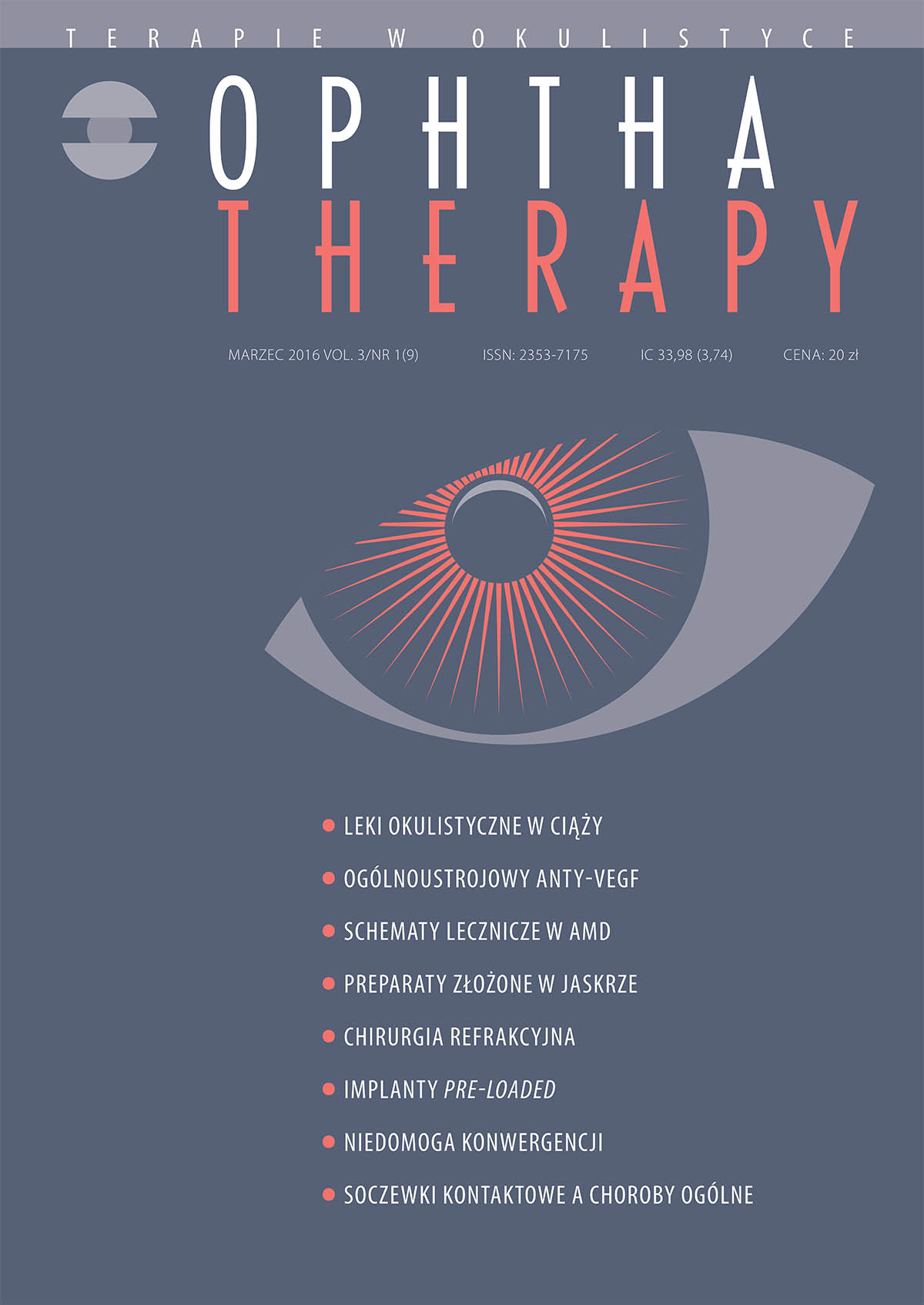System implantacji typu pre-loaded – właściwości nowego systemu UltraSert
##plugins.themes.bootstrap3.article.main##
Abstrakt
Cel: Przedstawienie pierwszych doświadczeń z implantacją soczewek wewnątrzgałkowych z w pełni zintegrowanego systemu UltraSert firmy Alcon.
Materiał i metody: 20 badanych z zaćmą niepowikłaną przydzielono do 2 grup. U wszystkich przeprowadzono rutynową fakoemulsyfikację z wszczepieniem soczewki tylnokomorowej AcrySof SN60WF o mocy 20–24 D za pomocą systemu UltraSert lub systemu do implantacji Monarch III i indżektora Royal. Dobór sposobu był losowy. Oceniano efektywność, bezpieczeństwo, funkcjonalność i korzyści zastosowanego rozwiązania. Badania kontrolne przeprowadzono w 1. i 7. dobie po zabiegu.
Wyniki: Wszystkie zabiegi przebiegły bez powikłań. Użycie UltraSert wiązało się z mniejszą liczbą manewrów przy centrowaniu, a czas implantacji był krótszy średnio o 10 s. Nie zaobserwowano uszkodzeń sztucznej soczewki.
Wnioski: Przygotowanie zestawu UltraSert do użycia jest proste i intuicyjne. Krzywa uczenia się całej procedury jest krótka, a błędy zdarzają się rzadko. Zintegrowane systemy implantacji zwiększają bezpieczeństwo operacji zaćmy.
Pobrania
##plugins.themes.bootstrap3.article.details##

Utwór dostępny jest na licencji Creative Commons Uznanie autorstwa – Użycie niekomercyjne – Bez utworów zależnych 4.0 Międzynarodowe.
Copyright: © Medical Education sp. z o.o. License allowing third parties to copy and redistribute the material in any medium or format and to remix, transform, and build upon the material, provided the original work is properly cited and states its license.
Address reprint requests to: Medical Education, Marcin Kuźma (marcin.kuzma@mededu.pl)
Bibliografia
2. Alio J, Rodriguez-Prats JL, Galal A. Advances in microincision cataract surgery intraocular lenses. Curr Opin Ophthalmol. 2006; 17: 80-93.
3. Lundström M, Barry P, Henry Y et al. Evidence-based guidelines for cataract surgery: guidelines based on data in the European Registry of Quality Outcomes for Cataract and Refractive Surgery database. J Cataract Refract Surg. 2012; 38: 1086-93.
4. Wenzel M, Kohnen T, Scharrer A et al. Ambulante Intraokularchirurgie 2012: Ergebnisse der Umfrage von BDOC, BVA, DGII und DOG. Ophthalmo-Chirurgie. 2013; 25: 213-22.
5. Bellucci R. An introduction to intraocular lenses: Material, optics, haptics, design and aberration. In: Guell JL (ed). Cataract. ESASO Course Series. Karger, Basel 2013: 38-55.
6. Lane SS, Burgi P, Milios GS et al. Comparison of the biomechanical behavior of foldable intraocular lenses. J Cataract Refract Surg. 2004; 30: 2397-402.
7. Bozukova D, Pagnoulle C, Jerome C. Biomechanical and optical properties of 2 new hydrophobic platforms for intraocular lenses. J Cataract Refract Surg. 2013; 39: 1404-14.
8. Cooper BA, Holekamp NM, Bohigian G et al. Case-controlstudy of endophthalmitis after cataractsurgery comparing scleral tunnel and clear corneal wounds. Am J Ophthalmol. 2003; 136: 300-5.
9. Colleaux KM, Hamilton WK. Effect of prophylactic antibiotics and incision type on the incidence of endophthalmitis after cataract surgery. Can J Ophthalmol. 2000; 35: 373-8.
10. Nagaki Y, Hayasaka S, Kadoi C et al. Bacterial endophthalmitis aftersmall-incision cataractsurgery. Effect of incision placement and intraocular lens type. J Cataract Refract Surg. 2003; 29: 20-6.
11. McDonnell PJ, Taban M, Sarayba M et al. Dynamic morphology of clear corneal cataract incisions. Ophthalmology. 2003; 110: 2342-8.
12. Taban M, Rao B, Reznik J et al. Dynamic morphology of sutureless cataract wounds – effect of incision angle and location. Surv Ophthalmol. 2004; 49(suppl 2): S62-72.
13. Miller J, Scott IU, Flynn HW Jr et al. Acute-onset endophthalmitis after cataractsurgery (2000–2004): incidence, clinicalsettings and visual acuity outcomes after treatment. Am J Ophthalmol. 2005; 139: 983-7.
14. Mayer E, Cadman D, Ewings P et al. A 10-year retrospective survey of cataract surgery and endophthalmitis in a single eye unit: injectable lenses lower the incidence of endophthalmitis. Br J Ophthalmol. 2003; 87: 867-9.
15. Zaluski S, Clayman HM, Karsenti G et al. Pseudomonas aeruginosa endophthalmitis caused by contamination of the internal fluid pathways of a phacoemulsifier. J Cataract Refract Surg. 1999; 25: 540-5.
16. Leslie T, Aitken DA, Barrie T et al. Residual debris as a potential cause of postphacoemulsification endophthalmitis. Eye. 2003; 17: 506-12.

